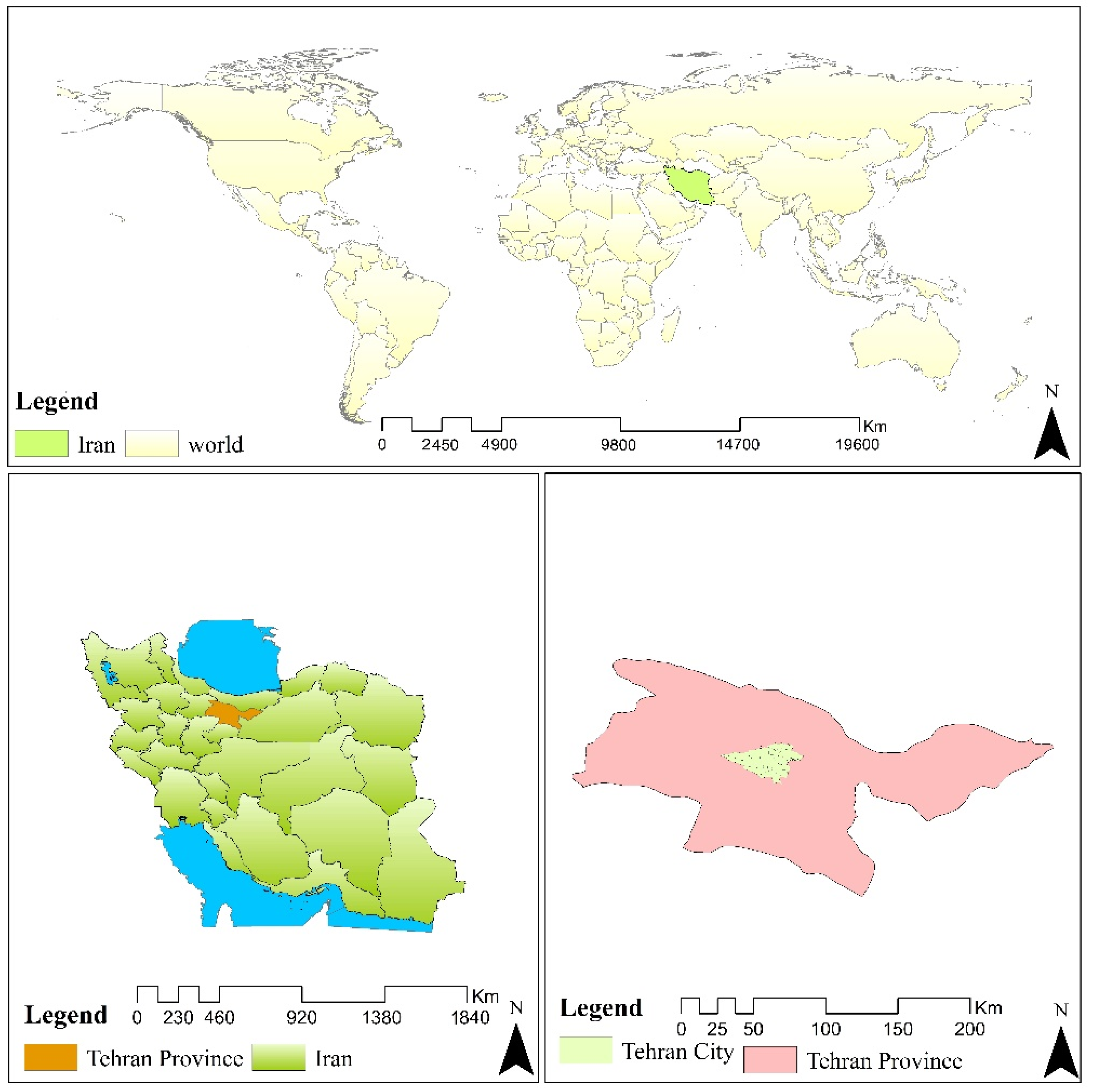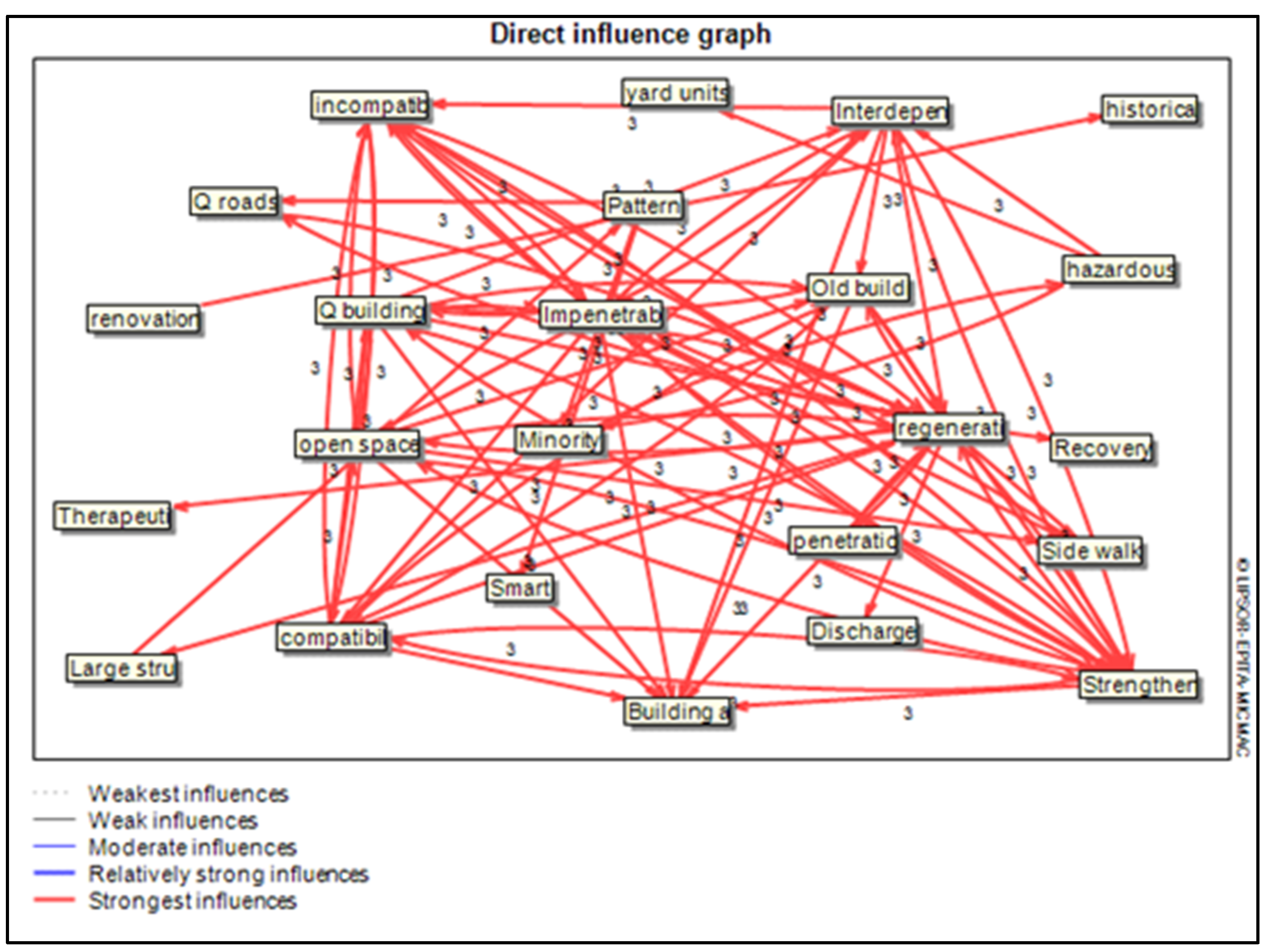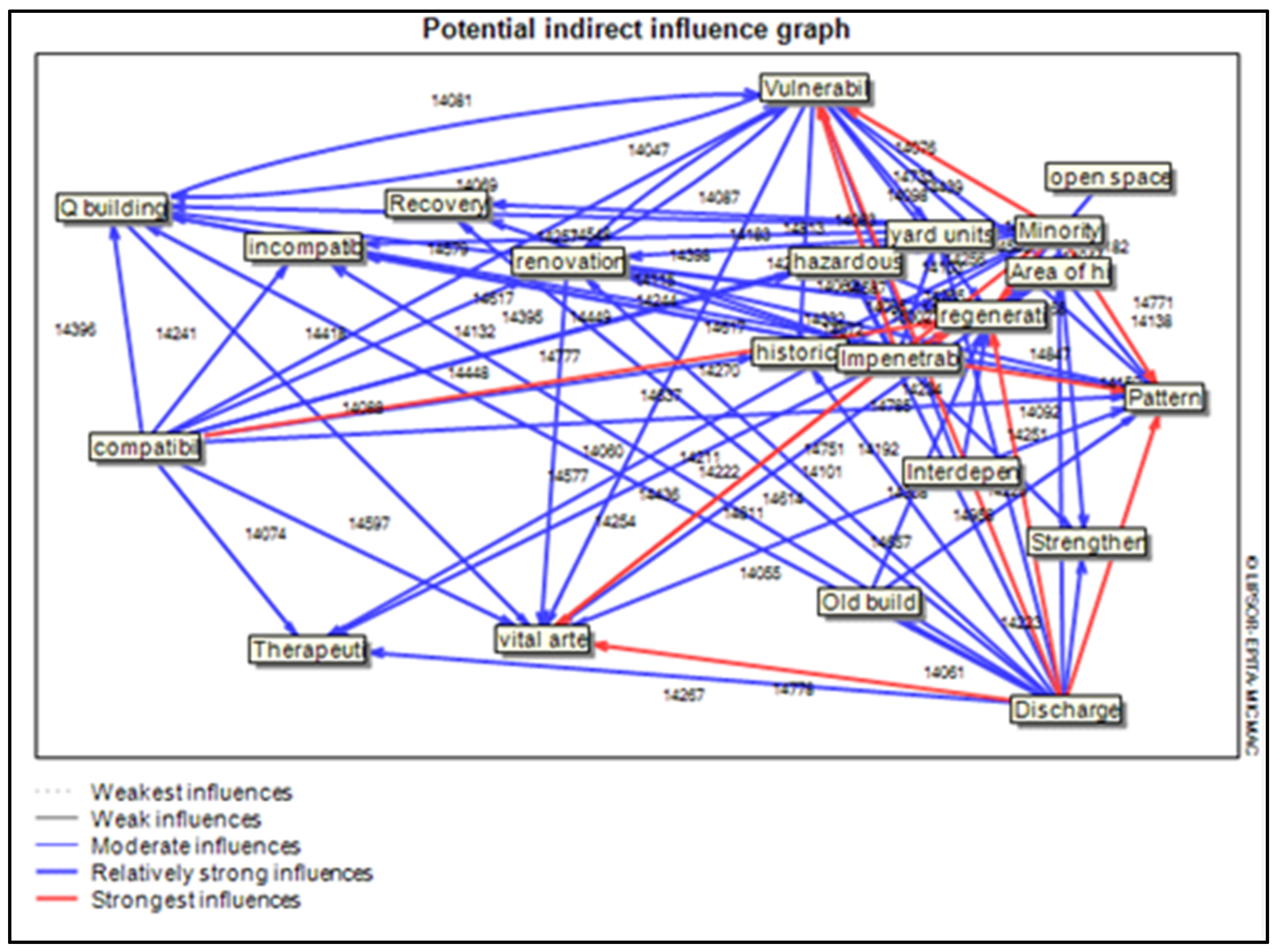Indicators Affecting the Urban Resilience with a Scenario Approach in Tehran Metropolis
Abstract
1. Introduction
2. Literature Review
2.1. The Concept of Resilience
2.2. Resilience Measurement and Analysis Models
3. Methodology
Study Area
4. Results
4.1. Trace Analysis-Dependence Matrix and Physical Resilience Indices’ Dispersion
4.2. Trace-Matrix-Indirect Dependence and Dispersion of Physical Resilience Indices
4.3. The Contribution of Comparative Direct and Indirect Physical Resilience Effectiveness and Susceptibility
4.4. Analyzing the Physical Resilience Variables’ Effectiveness and Susceptibility
5. Conclusions
Author Contributions
Funding
Informed Consent Statement
Data Availability Statement
Conflicts of Interest
References
- Carter, J.G.; Cavan, G.; Connelly, A.; Guy, S.; Handley, J.; Kazmierczak, A. Climate change and the city: Building capacity for urban adaptation. Prog. Plan. 2015, 95, 1–66. [Google Scholar] [CrossRef]
- Bibri, S.E.; Krogstie, J.; Kärrholm, M. Compact city planning and development: Emerging practices and strategies for achieving the goals of sustainability. Dev. Built Environ. 2020, 4, 100021. [Google Scholar] [CrossRef]
- Motesharrei, S.; Rivas, J.; Kalnay, E. Human and nature dynamics (HANDY): Modeling inequality and use of resources in the collapse or sustainability of societies. Ecol. Econ. 2014, 101, 90–102. [Google Scholar] [CrossRef]
- Jain, N.; Burman, E.; Stamp, S.; Shrubsole, C.; Bunn, R.; Oberman, T.; Barret, E.; Aletta, F.; Kang, J.; Raynham, P.; et al. Building performance evaluation of a new hospital building in the UK: Balancing indoor environmental quality and energy performance. Atmosphere 2021, 12, 115. [Google Scholar] [CrossRef]
- Tan, X.; Wu, Q.; Shao, H. Global commitments and China’s endeavors to promote health and achieve sustainable development goals. J. Health Popul. Nutr. 2018, 37, 8. [Google Scholar] [CrossRef]
- Department of Economic and Social Affairs, U.N. UN Department of Economic and Social Affairs; Revision of World Urbanization Prospects; DESA U.N.: New York, NY, USA, 2018. [Google Scholar]
- United Nations Office for Disaster Risk Reduction. The Human Cost of Natural Disasters: A Global Perspective; UNISDR: New York, NY, USA, 2015. [Google Scholar]
- Available online: https://www.laprensalatina.com/natural-disasters-caused-global-losses-of-72-billion-in-first-half-of-2022/ (accessed on 1 January 2020).
- Zeng, X.; Yu, Y.; Yang, S.; Lv, Y.; Sarker, M.N.I. Urban resilience for urban sustainability: Concepts, dimensions, and perspectives. Sustainability 2022, 14, 2481. [Google Scholar] [CrossRef]
- Jabareen, Y. Planning the resilient city: Concepts and strategies for coping with climate change and environmental risk. Cities 2013, 31, 220–229. [Google Scholar] [CrossRef]
- Kapucu, N.; Martín, Y.; Williamson, Z. Urban resilience for building a sustainable and safe environment. Urban Gov. 2021, 1, 10–16. [Google Scholar] [CrossRef]
- Zhao, J.; Liu, H.; Dong, R. Sustainable urban development: Policy framework for sustainable consumption and production. Int. J. Sustain. Dev. World Ecol. 2008, 15, 318–325. [Google Scholar]
- Mayunga, J.S. Understanding and Applying the Concept of Community Disaster Resilience: A Capital-Based Approach, Department of Landscape Architecture and Urban Planning, Hazard Reduction & Recovery Center, Texas A&M University. 2006. Available online: https://www.ucursos.cl/usuario/3b514b53bcb4025aaf9a6781047e4a66/mi_blog/r/11._Joseph_S._Mayunga.pdf (accessed on 1 January 2020).
- Kamranzad, F.; Memarian, H.; Zare, M. Earthquake risk assessment for Tehran, Iran. ISPRS Int. J. Geo. Inf. 2020, 9, 430. [Google Scholar] [CrossRef]
- Wardekker, A.; Wilk, B.; Brown, V.; Uittenbroek, C.; Mees, H.; Driessen, P.; Wassen, M.; Molenaar, A.; Walda, J.; Runhaar, H. A diagnostic tool for supporting policymaking on urban resilience. Cities 2020, 101, 102691. [Google Scholar] [CrossRef]
- Serre, D.; Heinzlef, C. Assessing and mapping urban resilience to floods with respect to cascading effects through critical infrastructure networks. Int. J. Disaster Risk Reduct. 2018, 30, 235–243. [Google Scholar] [CrossRef]
- Bexell, M.; Jönsson, K. Responsibility and the United Nations’ Sustainable Development Goals. Forum Dev. Stud. 2016, 44, 13–29. [Google Scholar] [CrossRef]
- Pede, E. Planning for Resilience: New Paths for Managing Uncertainty, 1st ed.; Springer Briefs in Geography; Springer: Berlin/Heidelberg, Germany, 2020. [Google Scholar]
- Rockefeller Foundation. 100 Resilient Cities Initiative. 2019. Available online: http://www.100resilientcities.org (accessed on 25 February 2019).
- Matyas, D.; Pelling, M. Positioning resilience for 2015: The role of resistance, incremental adjustment and transformation in disaster risk management policy. Disasters 2015, 39, S1–S18. [Google Scholar] [CrossRef]
- Meerow, S.; Newell, J.P. Urban resilience for whom, what, when, where, and why? Urban Geogr. 2019, 40, 309–329. [Google Scholar] [CrossRef]
- Holling, C.S.; Gunderson, L.H. Resilience and adaptive cycles. In Panarchy: Understanding Transformations in Human and Natural Systems; Island Press: Washington, DC, USA, 2002; pp. 25–62. [Google Scholar]
- Francis, R.; Behailu, B. A metric and frameworks for resilience analysis of engineered and infrastructure systems. Reliab. Eng. Syst. Saf. 2014, 121, 90–103. [Google Scholar] [CrossRef]
- Hataminejad, H.; Abdul, A.Y.; Farhadi, E.; Hossaini, F. An investigation of the life quality indices for improving the mental health of the citizens of Kaleybar in Iran. Int. J. Sci. Res. Sci. Eng. Technol. 2016, 1, 571–581. [Google Scholar]
- Hussaini, F.; Farhadi, E.; Pourahmad, A.; Tondelli, S. Spatial justice in relation to the urban amenities distribution in Austin, Texas. Spat. Inf. Res. 2022, 1–12. [Google Scholar] [CrossRef]
- Safdari Molan, A.; Farhadi, E.; Saganeiti, L.; Murgante, B. Border Tourism Development Strategies in Kaleybar Compared to Regional Rivals. Sustainability 2021, 13, 11400. [Google Scholar] [CrossRef]
- Blaauw, S.A.; Maina, J.W. Life Cycle Inventory for Pavements—A Case Study of South Africa. Transp. Eng. 2021, 3, 100049. [Google Scholar] [CrossRef]
- Aqbelaghi, A.S.; Ghorbani, M.; Farhadi, E.; Shafiee, H. Environmental approach in modelling of urban growth: Tehran City, Iran. Asian J. Water Environ. Pollut. 2018, 15, 47–56. [Google Scholar] [CrossRef]
- Blaauw, S.A.; Maina, J.W.; Mturi, G.A.; Visser, A.T. Flexible pavement performance and life cycle assessment incorporating climate change impacts. Transp. Res. Part D: Transp. Environ. 2022, 104, 103203. [Google Scholar] [CrossRef]
- UN/ISDR. Living with Risk—A Global Review of Disaster Reduction Initiatives, Inter-Agency Secretariat of the International Strategy for Disaster Reduction. 2004. Available online: http://www.unisdr.org/eng/about_isdr/bd-lwr-2004-eng.htm (accessed on 1 January 2020).
- Prieto Velandia, J.A. Risk-based resource allocation for management and pandemic response: The COVID-19 Case in Bogotá, Colombia. Master’s Thesis, Universidad Nacional de Colombia, Bogota, Colombia, 2022. [Google Scholar]
- Mitchell, T.; Harris, K. Resilience: A Risk Management Approach; ODI Background Note; Overseas Development Institute: London, UK, 2012; pp. 1–7. [Google Scholar]
- Wardekker, J.A.; de Jong, A.; Knoop, J.M.; van der Sluijs, J.P. Operationalising a resilience approach to adapting an urban delta to uncertain climate changes. Technol. Forecast. Soc. Change 2010, 77, 987–998. [Google Scholar] [CrossRef]
- Blaauw, S.A.; Maina, J.W.; Grobler, L.J.; Visser, A.T. A cumulative risk and sustainability index for pavements. Transp. Res. Part D Transp. Environ. 2022, 105, 103221. [Google Scholar] [CrossRef]
- Arvidsson, N.; Woxenius, J.; Lammgård, C. Review of road hauliers’ measures for increasing transport efficiency and sustainability in urban freight distribution. Transp. Rev. 2013, 33, 107–127. [Google Scholar] [CrossRef]
- Ainuddin, S.; Routray, J.K. Community resilience framework for an earthquake prone area in Baluchistan. Int. J. Disaster Risk Reduct. 2012, 2, 25–36. [Google Scholar] [CrossRef]
- Liao, K.H. A theory on urban resilience to floods—A basis for alternative planning practices. Ecol. Soc. 2012, 17, 48. [Google Scholar] [CrossRef]
- Blaauw, S.A.; Maina, J.W.; Grobler, L.J. Social life cycle inventory for pavements—A case study of South Africa. Transp. Eng. 2021, 4, 100060. [Google Scholar] [CrossRef]
- Allan, P.; Bryant, M. The critical role of open space in earthquake recovery: A case study. In Proceedings of the 2010 NZSEE Conference, Wellington, New Zeeland, 26–28 March 2010; pp. 1–10. [Google Scholar]
- Nelson, V.; Lamboll, R.; Arendse, A. Climate change adaptation, adaptive capacity and development discussion paper. In Proceedings of the DSA-DFID Policy Forum, Brussels, Belgium, 23 June 2008. [Google Scholar]
- Tobin, G. Sustainability and community resilience: The holy grail of hazards planning? Environ. Hazards 1999, 1, 13–25. [Google Scholar]
- Davis, I.; Izadkhah, Y.O. Building Resilient Urban Communities. Open House Int. 2006, 31, 11–21. [Google Scholar] [CrossRef]
- Department of Internation Development. Sustainable Livelihoods Guidance Sheets; DFID: London, UK, 2005.
- Cimellaro, G.P.; Renschler, C.; Reinhorn, A.M.; Arendt, L. PEOPLES: A framework for evaluating resilience. J. Struct. Eng. 2016, 142, 04016063. [Google Scholar] [CrossRef]
- Yodmani, S. Disaster Risk Management and Vulnerability Reduction: Protecting the Poor; Paper Presented at The Asia and Pacific Forum on Poverty; Asian Development Bank: Mandaluyong, Philipines, 2000. [Google Scholar]
- Buckle, P. New approaches to assessing vulnerability and resilience. Aust. J. Emerg. Manag. 2000, 15, 8–15. [Google Scholar]
- Skulmoski, G.J.; Hartman, F.T.; Krahn, J. The Delphi method for graduate research. J. Inf. Technol. Educ. 2007, 6, 1–21. [Google Scholar] [CrossRef]
- Godet, M.; Durance, P. Strategic Foresight for Corporate and Regional Development; Dunod: Malakoff, France; UNESCO: Paris, France, 2011. [Google Scholar]
- Hosseini, A.; Farhadi, E.; Hussaini, F.; Pourahmad, A.; Akbari, N.S. Analysis of spatial (in) equality of urban facilities in Tehran: An integration of spatial accessibility. Environ. Dev. Sustain. 2021, 24, 6527–6555. [Google Scholar] [CrossRef]
- Safdari Molan, A.; Farhadi, E. Spatial Analysis of the Proximity Effects of Land Use Planning on Housing Prices (Case Study: Tehran, Iran). In Proceedings of the ICCSA 2019: Computational Science and Its Applications, Saint Petersburg, Russia, 1–4 July 2019. [Google Scholar] [CrossRef]






| Row | Long Label | Short Label |
|---|---|---|
| 1 | Distribution status of hazardous land use (such as power plants, industrial uses, and flammable material stores) | Hazardous |
| 2 | Strength and safety of public spaces | Safety |
| 3 | Pattern of texture and form of the city (height, order, etc.) | Pattern |
| 4 | Public transportation facilities | Public tr |
| 5 | Vulnerability of roads (inside and near the market) | Vulnerabil |
| 6 | Vulnerability of vital arteries (water, electricity, gas, etc.) | Vital arte |
| 7 | Improvement and regeneration measures in the buildings of each zone | Regenerati |
| 8 | Vulnerable historical buildings | Historical |
| 9 | Buildings in which renovation measures have been carried out in relation to the whole building (locally or in general) | Renovation |
| 10 | Area of historic buildings to the total number of buildings in each zone | Area of hi |
| 11 | Percentage of yard units | Yard units |
| 12 | Minority | Minority |
| 13 | Smart infrastructures | Smart |
| 14 | Large structures | Large stru |
| 15 | Accessibility index and quality of main urban roads (safety, accessibility, asphalt, etc.) | Q roads |
| 16 | Vital pathway penetration coefficient | Penetratio |
| 17 | Recovery capacity | Recovery |
| 18 | Emergency evacuation capacity and rescue and security facilities (emergency, fire and police) | Discharge |
| 19 | Therapeutic capacity and relief base | Therapeuti |
| 20 | Sidewalk | Sidewalk |
| 21 | Old building | Old buildi |
| 22 | Land use compatibility | Compatibil |
| 23 | Quality of buildings | Q building |
| 24 | Building area | Building a |
| 25 | Reinforcement of communication bridges | Strengthen |
| 26 | Land use incompatibility rate | Incompatib |
| 27 | Impenetrability | Impenetrab |
| 28 | Interdependence of infrastructures | Interdepen |
| 29 | Existence of open space and temporary accommodation spaces | Open space |
| N° | Variable | Total Number of Rows | Total Number of Columns |
|---|---|---|---|
| 1 | Distribution status of hazardous land use (such as power plants, industrial uses, and flammable material stores) | 74 | 73 |
| 2 | Strength and safety of public spaces | 67 | 69 |
| 3 | Pattern of texture and form of the city (height, order, etc.) | 65 | 55 |
| 4 | Public transportation facilities | 68 | 63 |
| 5 | Vulnerability of roads (inside and near the market) | 70 | 73 |
| 6 | Vulnerability of vital arteries (water, electricity, gas, etc.) | 70 | 76 |
| 7 | Improvement and regeneration measures in the buildings of each zone | 75 | 74 |
| 8 | Vulnerable historical buildings | 74 | 75 |
| 9 | Buildings in which renovation measures have been carried out in relation to the whole building (locally or in general) | 75 | 69 |
| 10 | Area of historic buildings to the total number of buildings in each zone | 75 | 73 |
| 11 | Percentage of yard units | 70 | 75 |
| 12 | Minority | 76 | 70 |
| 13 | Smart infrastructures | 69 | 70 |
| 14 | Large structures | 67 | 71 |
| 15 | Accessibility index and quality of main urban roads (safety, accessibility, asphalt, etc.) | 63 | 67 |
| 16 | Vital pathway penetration coefficient | 65 | 67 |
| 17 | Recovery capacity | 52 | 73 |
| 18 | Emergency evacuation capacity and rescue and security facilities (emergency, fire and police) | 76 | 71 |
| 19 | Therapeutic capacity and relief base | 68 | 73 |
| 20 | Sidewalk | 67 | 68 |
| 21 | Old building | 72 | 72 |
| 22 | Land use compatibility | 75 | 68 |
| 23 | Quality of buildings | 72 | 69 |
| 24 | Building area | 58 | 71 |
| 25 | Reinforcement of communication bridges | 73 | 73 |
| 26 | Land use incompatibility rate | 70 | 68 |
| 27 | Impenetrability | 79 | 70 |
| 28 | Interdependence of infrastructures | 66 | 68 |
| 29 | Existence of open space and temporary accommodation spaces | 74 | 61 |
| Totals | 2025 | 2025 |
| Rank | Total Number of Rows | Variable | Total Number of Columns | Rank |
|---|---|---|---|---|
| 8 | 361,627 | Distribution status of hazardous land use (such as powerplants, industrial uses and flammable material stores) | 356,527 | 5 |
| 22 | 326,026 | Strength and safety of public spaces | 337,571 | 18 |
| 26 | 318,800 | Pattern of texture and form of the city (height, order, etc.) | 272,390 | 29 |
| 20 | 331,652 | Public transportation facilities | 307,287 | 27 |
| 16 | 340,759 | Vulnerability of roads (inside and near the market) | 355,694 | 8 |
| 17 | 340,163 | Vulnerability of vital arteries (water, electricity, gas, etc.) | 370,641 | 1 |
| 7 | 364,767 | Improvement and regeneration measures in the buildingsof each zone | 358,656 | 4 |
| 10 | 359,923 | Vulnerable historical buildings | 364,873 | 3 |
| 6 | 365,370 | Buildings in which renovation measures have beencarried out in relation to the whole building (locally or ingeneral) | 337,335 | 20 |
| 5 | 366,160 | Area of historic buildings to the total number of buildingsin each zone | 356,455 | 7 |
| 15 | 342,591 | Percentage of yard units | 365,585 | 2 |
| 2 | 370,024 | Minority | 340,237 | 17 |
| 18 | 337,146 | Smart infrastructures | 340,756 | 16 |
| 23 | 325,943 | Large structures | 347,890 | 12 |
| 27 | 309,128 | Accessibility index and quality of main urban roads(safety, accessibility, asphalt, etc.) | 328,327 | 25 |
| 25 | 319,768 | Vital pathway penetration coefficient | 327,978 | 26 |
| 29 | 256,986 | Recovery capacity | 356,505 | 6 |
| 3 | 369,352 | Emergency evacuation capacity and rescue and securityfacilities (emergency, fire and police) | 345,670 | 13 |
| 19 | 333,115 | Therapeutic capacity and relief base | 355,659 | 9 |
| 21 | 326,337 | Sidewalk | 334,300 | 21 |
| 13 | 351,011 | Old building | 350,100 | 11 |
| 4 | 366,365 | Land use compatibility | 333,748 | 22 |
| 12 | 352,918 | Quality of buildings | 337,499 | 19 |
| 28 | 284,731 | Building area | 344,524 | 14 |
| 11 | 355,009 | Reinforcement of communication bridges | 355,201 | 10 |
| 14 | 344,434 | Land use incompatibility rate | 331,008 | 24 |
| 1 | 385,014 | Impenetrability | 342,476 | 15 |
| 24 | 321,738 | Interdependence of infrastructures | 332,962 | 23 |
| 9 | 360,115 | Existence of open space and temporary accommodationspaces | 299,118 | 28 |
| 2025 | Totals | 2025 |
Publisher’s Note: MDPI stays neutral with regard to jurisdictional claims in published maps and institutional affiliations. |
© 2022 by the authors. Licensee MDPI, Basel, Switzerland. This article is an open access article distributed under the terms and conditions of the Creative Commons Attribution (CC BY) license (https://creativecommons.org/licenses/by/4.0/).
Share and Cite
Farhadi, E.; Pourahmad, A.; Ziari, K.; Faraji Sabokbar, H.; Tondelli, S. Indicators Affecting the Urban Resilience with a Scenario Approach in Tehran Metropolis. Sustainability 2022, 14, 12756. https://doi.org/10.3390/su141912756
Farhadi E, Pourahmad A, Ziari K, Faraji Sabokbar H, Tondelli S. Indicators Affecting the Urban Resilience with a Scenario Approach in Tehran Metropolis. Sustainability. 2022; 14(19):12756. https://doi.org/10.3390/su141912756
Chicago/Turabian StyleFarhadi, Ebrahim, Ahmad Pourahmad, Keramatollah Ziari, Hassanali Faraji Sabokbar, and Simona Tondelli. 2022. "Indicators Affecting the Urban Resilience with a Scenario Approach in Tehran Metropolis" Sustainability 14, no. 19: 12756. https://doi.org/10.3390/su141912756
APA StyleFarhadi, E., Pourahmad, A., Ziari, K., Faraji Sabokbar, H., & Tondelli, S. (2022). Indicators Affecting the Urban Resilience with a Scenario Approach in Tehran Metropolis. Sustainability, 14(19), 12756. https://doi.org/10.3390/su141912756








